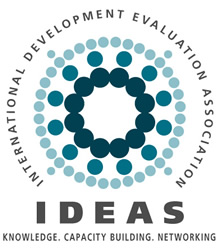IDEAS’ EvalFCV Going Places:
On January 18th, Hur Hassnain, IDEAS Board Member for Asia Pacific region and Chair of our EvalFCV TIG conducted a talk on evaluation in fragility, conflict and violence at DEval, German Institute for Development in Bonn. The talk was attended by different teams at DEval office, The German Development Institute (DIE), The Deutsche Gesellschaft für Internationale Zusammenarbeit (GIZ), Gustav-Stresemann-Institut, Afghan Credit Guarantee Foundation and Madiba Consult.
Hur, in his presentation discussed the key challenges of evaluation in conflict and fragility. Hur said that evaluation, like development aid, can also, unintendedly, exacerbate tensions in ways that negatively impact conflict-affected populations if care is not taken to develop and integrate conflict sensitivity into the evaluation design and approaches adopted. There is an evolving body of literature on conflict sensitivity in the design and monitoring of development, humanitarian and conflict prevention assistance (Goldwyn and Chigas, 2013 and Pathways for Peace, World Bank[1]). But there has been less information made available on how to design and conduct evaluations in conflict-sensitive ways in FCV environments.
Speaking about the importance of evaluation in FCVs, Hur said that these environments tend to be politically volatile and it can be difficult to navigate who are the key stakeholders to have on board for an authentic evaluation process. It can be challenging to find the appropriate direction/purpose for the evaluation. Not everyone is neutral in such contexts but how can one address such challenges when it comes to evaluation?
Hur informed the participants about the recent developments at the EVALFCV TIG especially the creation of a Quick How To Guide. This Guide will be launched at the IDEAS’ General Assembly in October 2019 in Prague.
Hur’s presentation revolved around 10 steps for designing, commissioning, managing and conducting evaluations in FCV environments. These 10 steps are:
Step 1: Conduct Stakeholder, Political and Social Analysis, to the extent possible (using emerging data from humanitarian and other sources)
Step 2: Co-Design a Conflict and Gender Sensitive Evaluation Framework, Approach and a Stakeholder Communication Strategy. Prioritize participatory methods to ensure evaluation approach and questions are contextually sensitive.
Step 3: Ensure safety of the evaluation team
Step 4: Use conflict and gender sensitive evaluation methods and tools, informed through a participatory approach.
Step 5: Conduct scoping mission or Pilot to test tools before conducting evaluation in full. Incorporate lessons; eliminate any harmful practices.
Step 6: Create or re-create the programme Theory of Change.
Step 7: Collect primary data (remotely)
Step 8: Measure unintended effects and its consequences
Step 9: Close the evaluation feedback loop with persons that can effect positive change, including peacebuilding or harm reduction based on the evaluation findings; and to the affected populations that may have taken risks to participate.
Step 10: Disseminate and utilise evaluation for course correction and adaptive learning. In the context of FCV, this may lead to reduced harm, citizen protection, reduced vulnerability of affected populations, etc. One could argue that the timely use of evaluation in an FCV setting is perhaps more important than even standard evaluation
Please contact Hur Hassnain for more details hurhassnain@hotmail.com.


